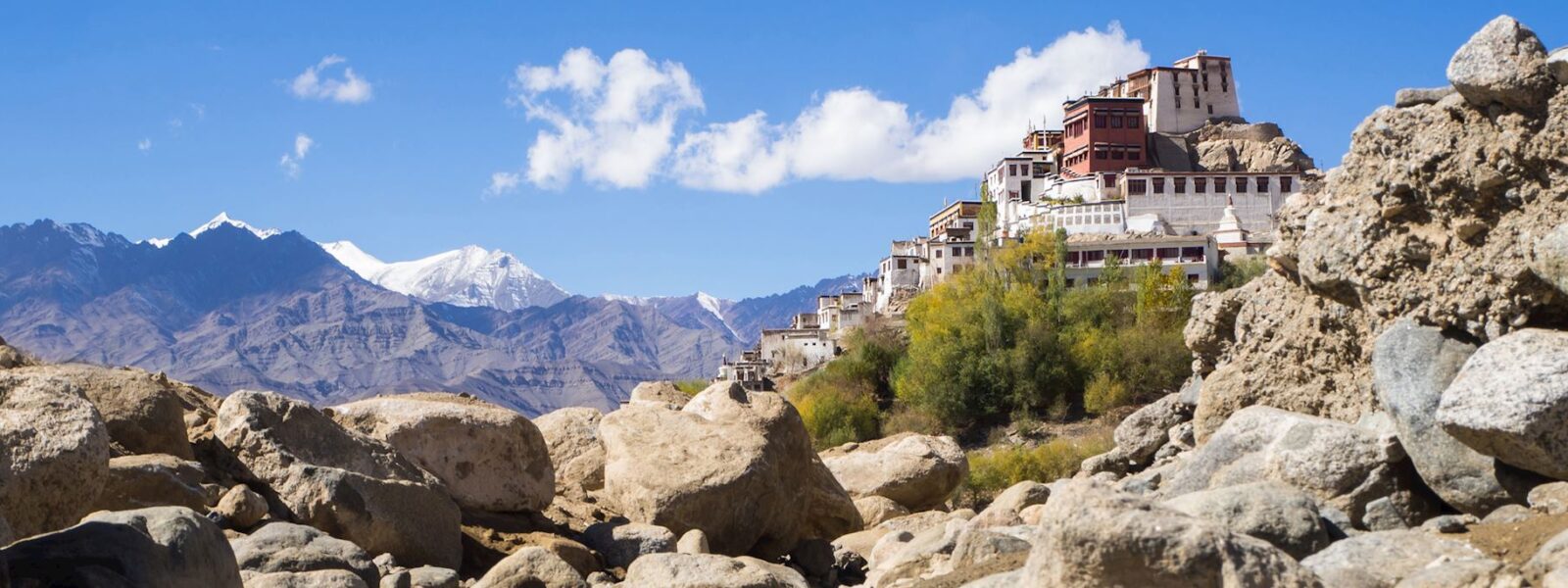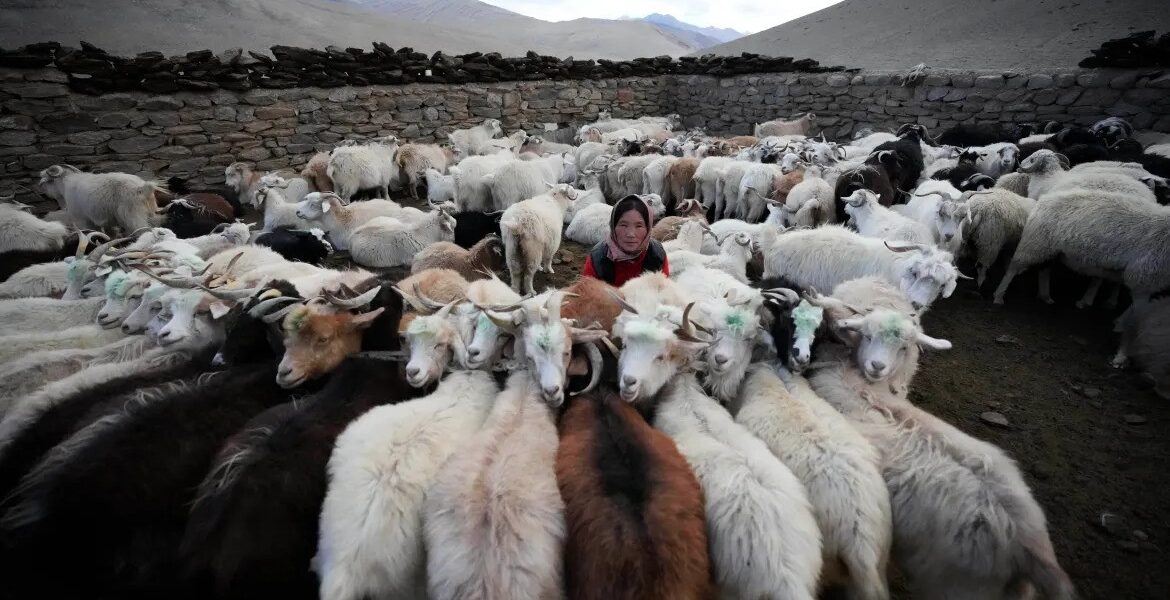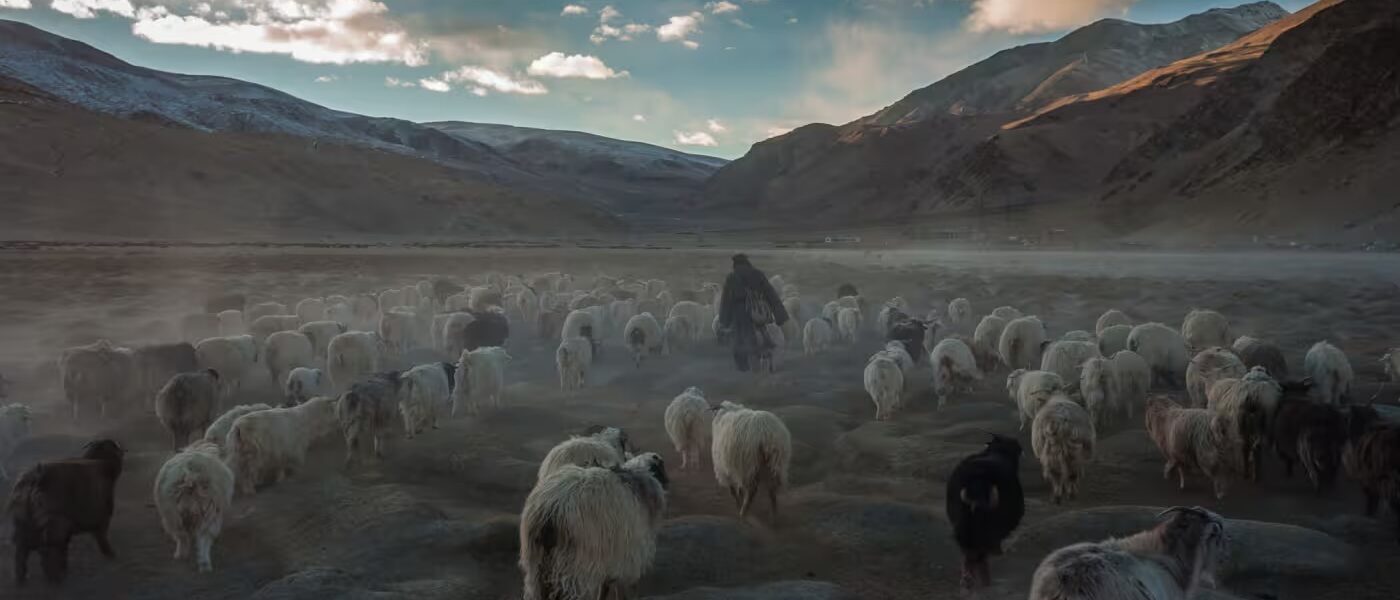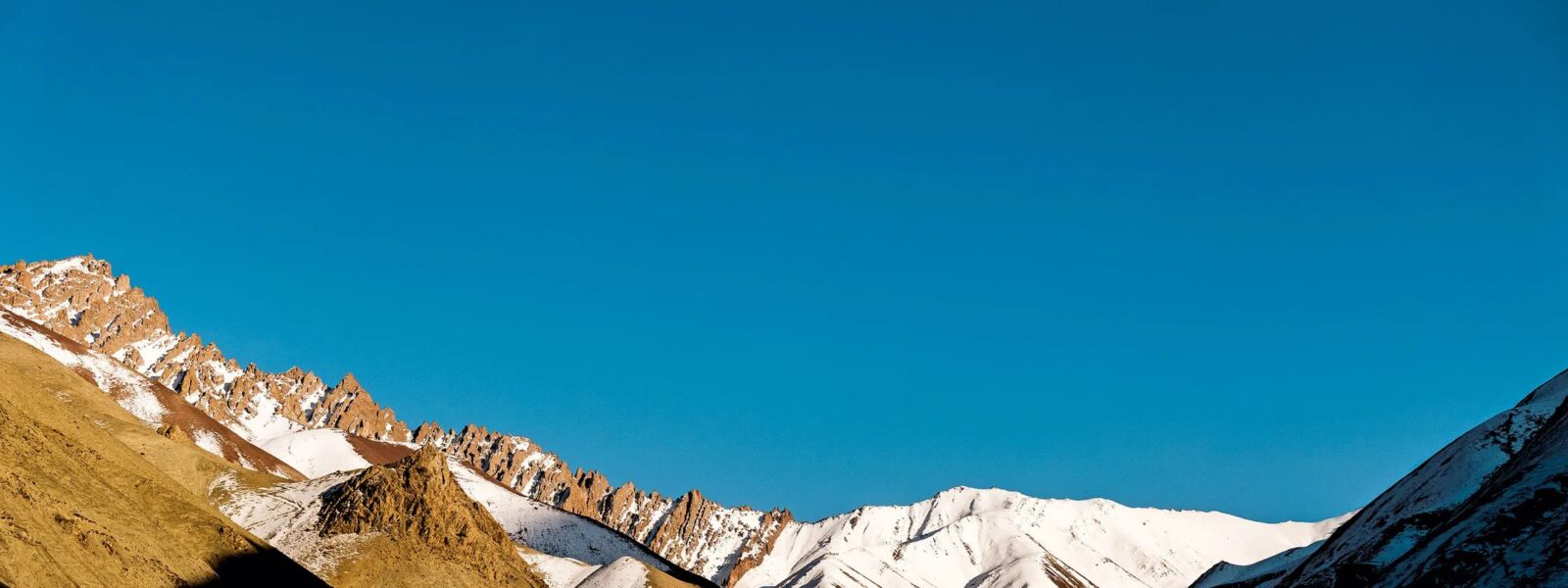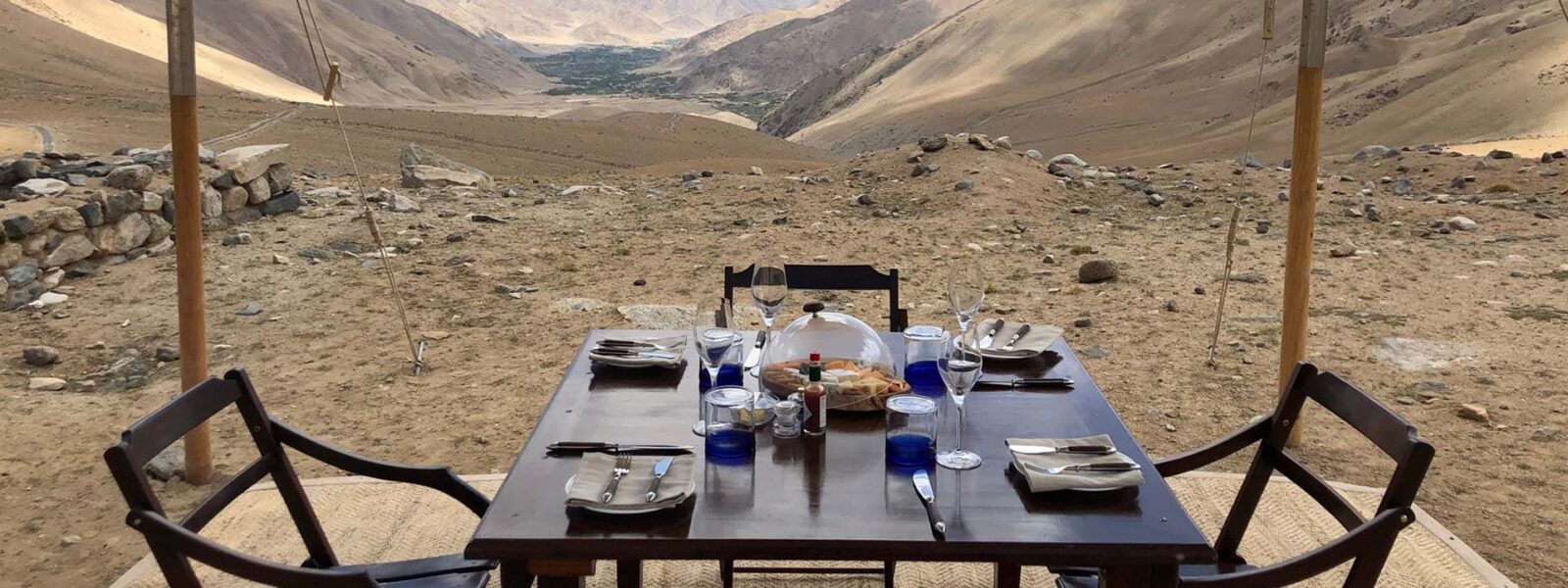The Hour When Shadows Faint and Thoughts Deepen
Somewhere Between White and Gold
Noon in Ladakh arrives not with fanfare, but with a quiet assertion. It does not cast long dramatic shadows like dawn or dusk. It does not make you shiver as the early morning does, nor does it swaddle the hills in a tangerine glow. Instead, it does something subtler—and far more difficult to describe. The light is bleached, almost *too pure*. It hums. It hovers. It becomes the texture of the air itself.
You would be forgiven for assuming the high Himalayan sun at midday would paint everything in brilliant white. But it doesn’t. Not quite. Nor does it gild the world with the golden touch of late afternoon. The colour of noon in Ladakh lies somewhere between these extremes—a pale, almost spectral tint, where the sky sharpens into cobalt and the mountains begin to blur at their edges. It is a moment when the familiar shades lose their vocabulary, and the land speaks in a language of tone and contrast.
In villages like Tingmosgang or across the open valleys of Zanskar, the sun at its apex flattens the world. Objects lose their depth; stones cast no meaningful shadow. This visual erasure is not emptiness—it is precision. The harshness of Ladakh’s light at noon does not overwhelm, but rather refines. It reveals every imperfection in a prayer-flag’s edge, the delicate threads of a monk’s robe drying on a ledge, or the crow’s footprint etched in dust by the monastery gate.
This is light sculpted by altitude, by silence, and by centuries of sky. It is the *midday moment* that has turned many a traveller into a listener. For in that hour, the world no longer asks to be photographed. It asks to be seen.
Noon in the Cold Desert
The cold desert of Ladakh, at 3,500 meters above sea level, is a contradiction even at the best of times. But never more so than at noon. The sun burns, but the air does not warm. The ground is cracked and dry, yet the breeze that travels over it is glacial. One might sit beneath a willow by a stream, feet in the water, sun on the brow, and still reach for a shawl. This paradox—of heat without comfort, of brilliance without warmth—is what defines the experience of midday in Ladakh.
From the roadside chortens of the Sham Valley to the open expanses near Tso Moriri, the high-altitude light turns unforgiving at noon. Tourists attempting photographs often complain: too flat, too bright, no contrast. But for those who stop trying to capture the view and simply sit with it, there is a shift. An acceptance. At high noon, Ladakh is not picturesque. It is precise.
This is a time when time itself becomes brittle. When even the dogs sleep in the shade of prayer walls, and locals—both human and animal—respect the authority of the sun. Ladakh at noon is not meant to be productive. It is meant to be survived. But within that pause lies its poetry.
Noon in Ladakh is not golden. It is not white. It is a colour unnamed—one that rests just beneath the surface of things, waiting for you to stop long enough to notice.
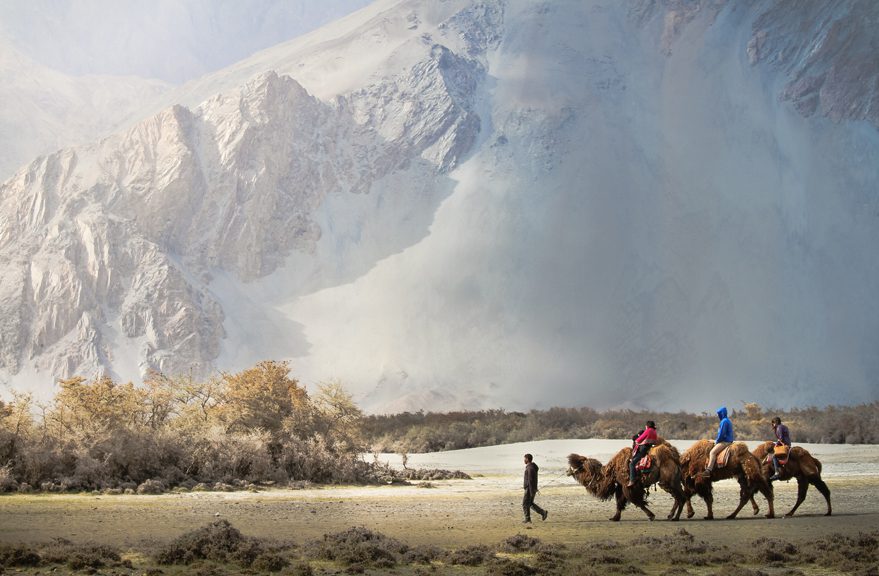
A Silence That Speaks in Midday Tones
The Villages Go Still
At noon, even the smallest Ladakhi villages seem to inhale and then hold their breath. The courtyards that echoed with the scrape of brooms in the morning now fall quiet. Children disappear behind thick wooden doors, animals gather under eaves, and the low hum of daily life fades into a hush so complete it seems deliberate. This is not the hush of absence, but of reverence—an unspoken truce between the people and the sun.
In places like Alchi, Domkhar, or Hemis Shukpachan, the air grows still, even heavy, though it carries no heat. Everything slows to a crawl, as if the landscape itself requires a moment of suspension. There is no movement on the road except the rare shimmer of a heat mirage rising above the tarmac. And yet, this stasis is full of life. Somewhere behind a half-closed window, a butter lamp flickers beside a faded photograph of a lama. In the corner of a shaded kitchen, an old woman spins wool slowly between fingers and thumb. Life at noon is less visible, but more rooted.
It is in this stillness that one begins to understand how deeply spiritual Ladakh is—not in the abstract, but in the lived, ordinary way. The silence of noon is the same silence that dwells in monastery walls, in prayer wheels set spinning by the wind. It is not a silence of emptiness, but of listening. It teaches you how not to interrupt.
There are no signs announcing it, no ritual to mark its start. But ask a villager about the time between late breakfast and afternoon chores, and they will tell you with a smile: “That is the hour of sitting.” A phrase as simple as it is profound.
Time Unwinds Differently Here
In Ladakh, time bends at noon. It does not march, nor does it flow—it loosens. You can feel it in your bones as you sit beneath the overhang of a mud-brick home, your back resting against centuries of sun-hardened stone. The breeze no longer nudges; it waits. The prayer flags above you flutter not with haste but with memory. A minute stretches into an hour, and the mind, stripped of distraction, becomes still enough to receive the land.
For the European traveler, accustomed to the busy symmetry of itineraries, this can be unsettling. But it is also a gift. In the West, noon is a time of motion—of business lunches and swipes of the clock. In Ladakh, it is the eye of the day’s storm, a pause so complete that even thoughts become reluctant to interrupt it. Here, the experience of travel becomes less about movement and more about attunement.
One begins to notice things otherwise missed: the fine powder of apricot dust on the sill, the hum of a bee drunk on thin mountain nectar, the small shadow of a sparrow moving across the courtyard wall like a brief second hand. These are the seconds of Ladakh’s clock at noon.
If you are lucky, you’ll find yourself doing nothing at all—just being in the colour of that silence. And when you rise, you will not know how much time has passed. Only that it passed differently.
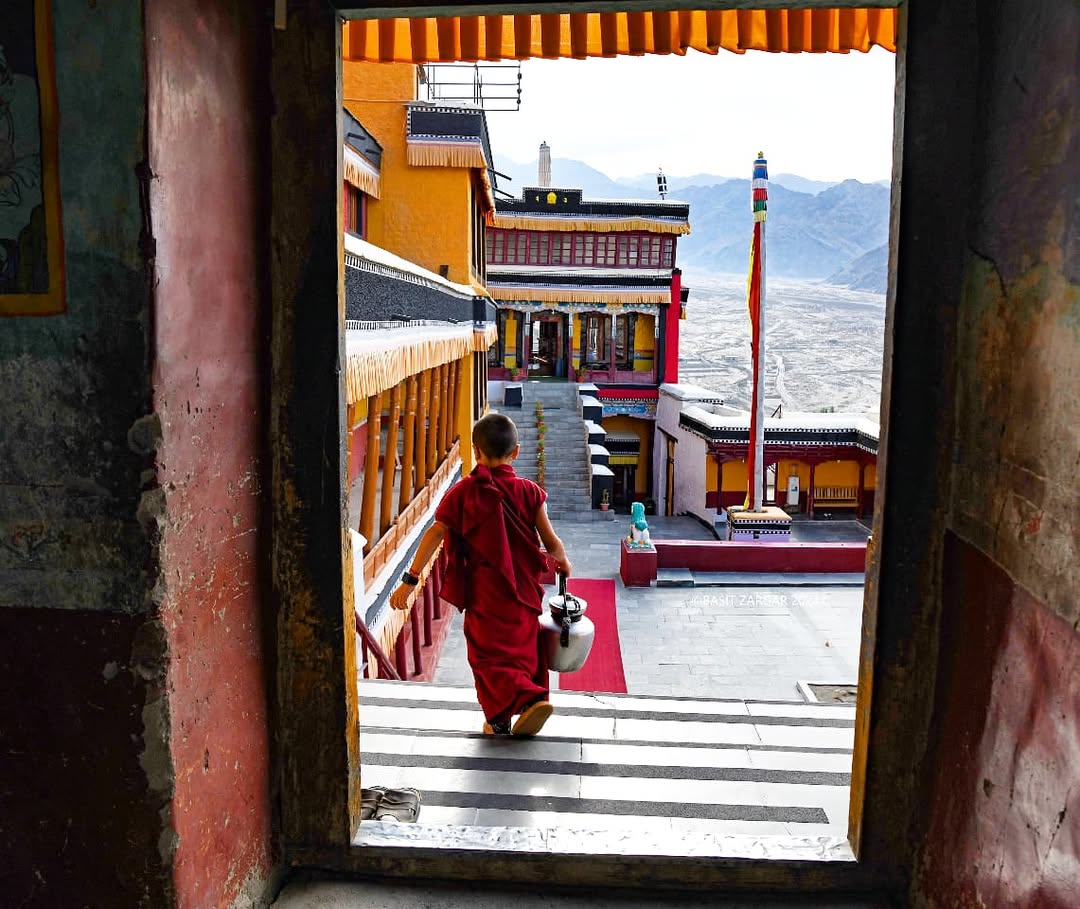
The Alchemy of Altitude and Atmosphere
Thin Air and Brilliant Light
To understand noon in Ladakh, one must begin with altitude. The land here does not merely rise—it ascends. At 3,500 metres and higher, the air thins into transparency. It lacks the moisture to diffuse light, lacks the pollutants to soften it. What remains is a kind of brilliance, pure and undiluted, that seems to pierce rather than bathe.
Under this high-altitude sun, light behaves differently. It sharpens edges and pulls shadows taut before erasing them altogether. Surfaces do not shimmer; they radiate. The whitewashed stupas that dot the hills appear not luminous, but atomic, pulsing with an intensity that is almost difficult to look at. And yet, for all this optical force, there is a strange coldness. The sun does not warm you—it examines you.
In the moments just past noon, when the sun tips slightly beyond its apex, the landscape begins to change once more. The hard light becomes momentarily forgiving. But at its peak, the light is law. There is no softness, no gradient, no tolerance for imperfection. The noon light in Ladakh reveals everything—cracks in a prayer wall, the fatigue etched into a traveller’s face, the ancient erosion on the cheek of a Buddha carved into rock.
Photographers often find this hour impossible, and yet, it is the most honest. There are no tricks. What you see is what exists. It is a time of clarity so absolute, it becomes uncomfortable. And this discomfort is not a flaw, but a threshold.
When the Sky Closes In
Look up at noon, and you will not see the familiar sky. You will see something deeper, denser. The blue above Ladakh at midday is not a sky but a ceiling—high, hard, unyielding. It stretches over the landscape with a kind of finality, as if nothing more could possibly be above it. The effect is unsettling and magnificent.
This is where the atmosphere plays its final card. Without dust, without water vapour, without the common veil of life below 2,000 metres, the sun reigns unchecked. The sky turns a hue so rich it borders on violet, and the land beneath it shrinks into geometric shapes of stone and soil. The mountains lose their softness. Their forms become angular, almost mathematical, under the relentless light.
You may find yourself standing by the edge of a pasture, watching a herd of dzos pause in their slow chewing, as if they too are held captive by this brightness. There is no rustle, no wind. Only the sound of blood in your ears, magnified by silence. In that moment, you are aware of the sun not just above, but inside you—entering through your eyes, warming your bones without ever touching your skin.
Altitude strips away softness. It trades comfort for precision. And noon is its sharpest hour.
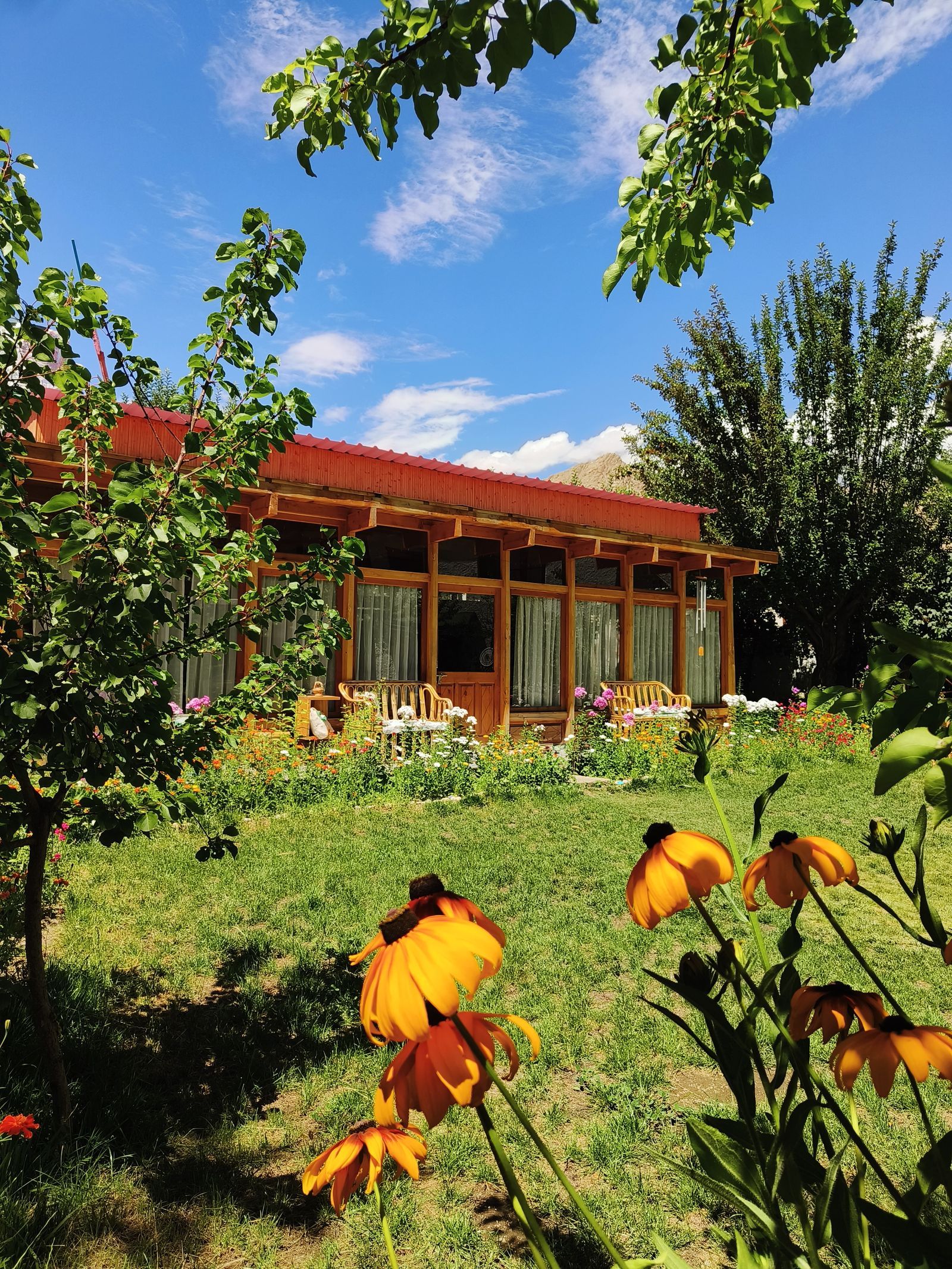
What the Camera Cannot Capture
Between the Frame and the Feeling
Every traveller to Ladakh arrives with a camera. It is instinct. The desire to hold on to beauty, to catalogue awe. But at noon, those devices fail us. The lenses struggle. The exposures flatten. The hues vanish. What remains is a photograph that looks unremarkable—pale walls, too-bright skies, subjects stripped of shadow and texture. A silence lost in translation.
One can manipulate ISO, adjust white balance, switch lenses—but still, something evades capture. It is not just the light that resists; it is the mood, the stillness, the uneasy brilliance. The camera tells you that nothing is happening. But that is only because it cannot read what lives between the frames.
Noon in Ladakh is not made for media. It is a live performance of absence. The shadows, minimal and trembling, are not dramatic enough for postcards. The colours—faint, dusted, trembling on the edge of recognition—are simply too subtle for pixels. But the traveller, standing motionless in the courtyard of a monastery or by the braided banks of the Indus, feels something real and difficult to name.
This is not to say that noon is unphotographable—it is simply unpossessable. It refuses reproduction. It must be experienced, not archived. In that resistance lies its rarest gift: presence. The camera may fail, but your senses will not.
A Memory Written in Shadow
You will remember Ladakh’s noon not for what you saw, but for what you felt. The absence of movement. The hard clarity of the stones beneath you. The pause in time. You will remember the way your own shadow nearly vanished at your feet, and how, for a strange moment, you forgot you had a name.
That memory—intact, wordless—will come back to you not in photographs, but in dreams. It will rise years later while standing in some European square at midday, where the sun feels polite and the shadows reliable. You will recall the brittle silence of noon in the Himalayas and wonder if it had truly happened.
And when someone asks to see your pictures of Ladakh, you will hesitate. You’ll swipe through images of stupas and passes and apricot blossoms, but none will show that otherworldly hour. None will show the noon that asked nothing of you but stillness.
For that colour, that hour, that silence—those belong only to the ones who stood inside them.
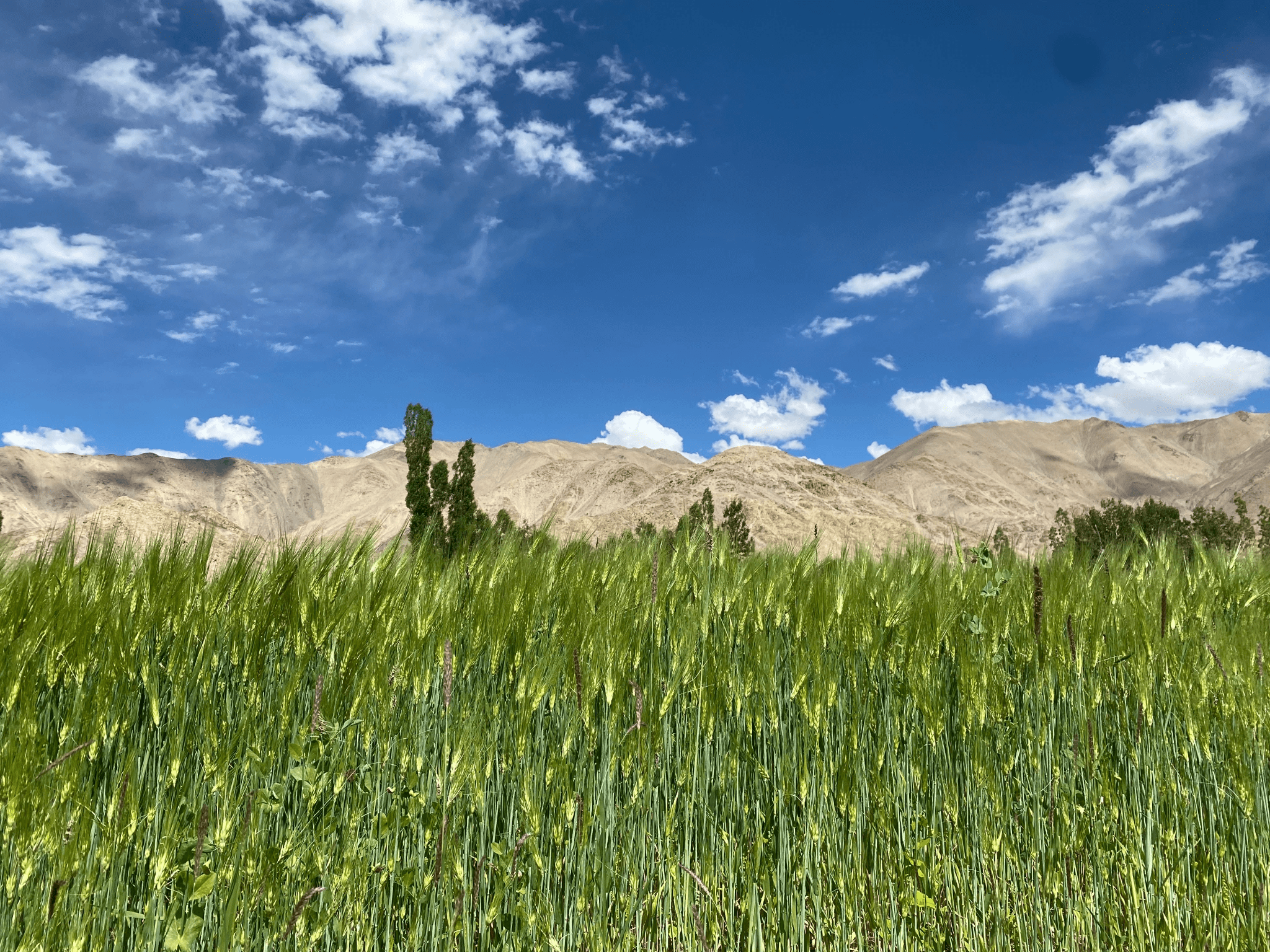
Practical Silence: When to Witness It Yourself
A Time Hidden in Plain Sight
There is no itinerary slot labeled “noon silence” in Ladakh. No map pinpoints the precise curve in the road where the shadows vanish. And yet, if you find yourself here between the hours of eleven-thirty and one-thirty, particularly in the months between June and September, you may step into this forgotten hour by accident.
Late morning treks through the Indus Valley or the upper reaches of Nubra might deposit you on a rock, out of breath, just as the world begins to dissolve into stillness. In that moment, do not move on. Rest. Watch. The visual flatness is not the absence of beauty—it is its refinement. Allow your eyes to adapt to the thinness of contrast. Let the high-altitude light begin to teach you.
Where to Be When the Light Peaks
The best places to experience this phenomenon are often the least spectacular. A shaded alleyway in Lamayuru. The abandoned yard behind a guesthouse in Turtuk. A silent outcrop above Uley. These are not postcard moments, but the places where Ladakh reveals its private self. You may not even realize you’ve entered that hour until the noise of your own breath feels too loud.
For those who prefer more open spaces, the shores of Tso Kar or the pastures near Rumtse offer a sky-wide canvas. But even then, it is not the view that matters—it is your attention. Noon in Ladakh is not a spectacle. It is a narrowing of perception. And once it passes, the world resumes as if nothing had happened.
One Final Note to the Traveller
There will always be a temptation to fill your days here. To move from monastery to monastery, from summit to summit, from story to story. But if you can, leave a window open in your schedule. Sit beside a Ladakhi grandmother shelling apricots. Wait under the shade of a mani wall. Put your camera down. Let the light find you.
The colour of noon in Ladakh cannot be bought or booked. It must be stumbled into. It is the hour when the desert becomes transparent, the sky becomes solid, and time—just briefly—vanishes.
And when you return home, you may forget the names of passes or the elevations of lakes. But you will not forget the feeling of that one hour when the land, the light, and your own breath stood perfectly still.
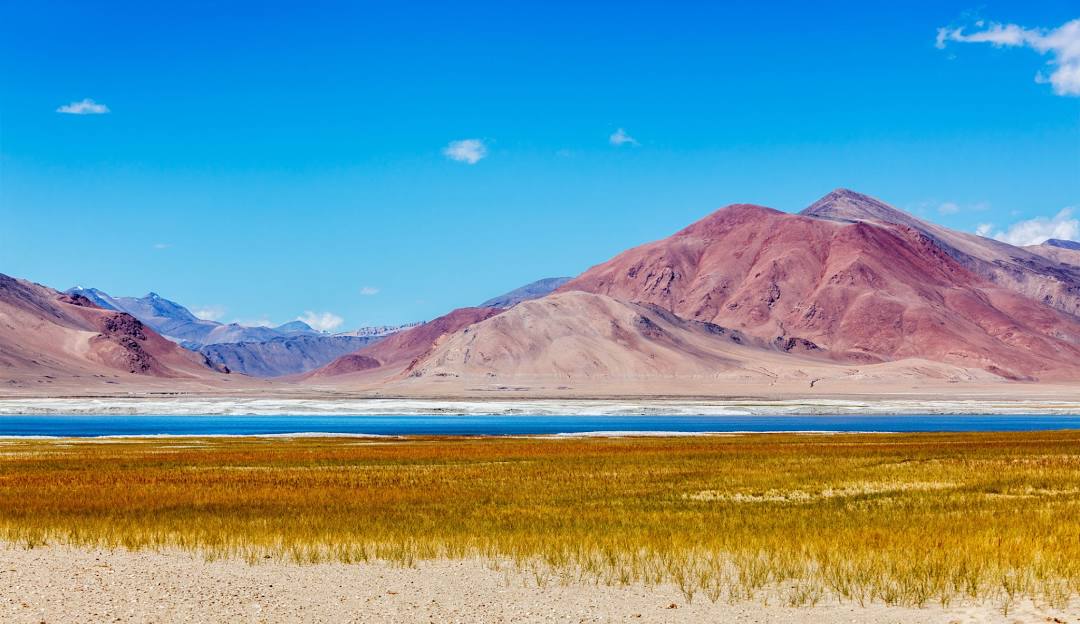
About the Author
Edward Thorne is a British travel writer and former geologist whose prose is marked by sharp observation, restrained emotion, and an unwavering devotion to the physical world.
He does not describe feelings — he describes what is seen, heard, touched. In his writing, a cracked valley floor or a half-buried stone tells more about the human condition than any metaphor could. Through this tactile fidelity, readers encounter the silence, awe, and disquiet that define Earth’s remote edges.
Edward’s journeys have taken him from Icelandic fjords to Tibetan plateaus, but he returns to the Himalayas again and again—not for answers, but for the stark clarity that only high, wind-swept altitudes can offer. He believes that beauty lives not in drama, but in detail.
He currently divides his time between a stone cottage in Northumberland and the high deserts of Ladakh, where he walks, writes, and drinks tea in long silences.

